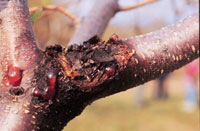As the good bugs are over-wintering or hibernating, so are the bad bugs.
Many of our major pests are introduced from elsewhere and have a period in their lifecycle that protects them from winter cold and little or no food supply.
These pests are in sync with their host trees. The pests are ‘winterised’ as are their host trees.
In spring as the trees come out of dormancy, the pests also start the next stage in their life cycle.
This is the hardest time of year to control these pests as they are tuned to winter—they are protected from the cold, rain, frosts etc. and very difficult to get to.
Parasites and predators are also experiencing the winter, with little activity over this period. Some predators and parasites will be feasting on other pests in different crops and will move into the orchards during spring when the orchard pests can be attacked.
Monitor pest levels
Checking San Jose Scale levels, Woolly Apple Aphid parasitism, scraping bark and checking for Mealy Bug and levels of parasitism, are options to help indicate the level of the pest and its control by predators and parasites.
Disease control and management
One of the most important IPM activities now is disease control and management.
A classic IPM activity is removing leaves from the orchard to reduce the carry-over of spores from Apple Scab/Black Spot.
Not so practical in our situation, but spraying the leaves with nitrogen to increase the biological activity to breakdown the leaves and reduce the spore carryover is a realistic option.
Pruning
Pruning is a significant time for setting up IPM for the coming season.
Removing stonefruit mummies to reduce Brown Rot spore load in stonefruit is a must.
Different spots on laterals and leaders may indicate a range of diseases. What does Powdery Mildew on apple wood, or Leucostoma canker on peach laterals look like?
Tree planting tip
With the forecast for winter being dryer than average (in our area it is quite dry now), planting trees into dry conditions is reminiscent of the drought only two seasons ago.
Other areas are quite wet, so this tip may be useful for some areas.
Work from the IFTA in European nurseries and growers have demonstrated their research methods used to prepare trees for planting.
Hydrating bare rooted trees
All methods centred on the importance of hydrating bare rooted trees prior to planting.
The Europeans found that trees get a better start by soaking the tree’s roots in water for 24 to 48 hours prior to planting.
This soaking will hydrate plants to twice their weight and will provide 30 days of water in the new planting.
This greatly reduces the stress associated with the drying of soil around the roots shortly after planting.
The Europeans report that trees hydrated by a good pre-plant soaking will also give trees a 30 day head start over trees handled in the traditional fashion.
European growers report that they completely submerge the trees in water (although only the roots need to be submerged) for at least 24 hours.
For more information and images of diseases, download the August 2012 issue of Tree Fruit.




















